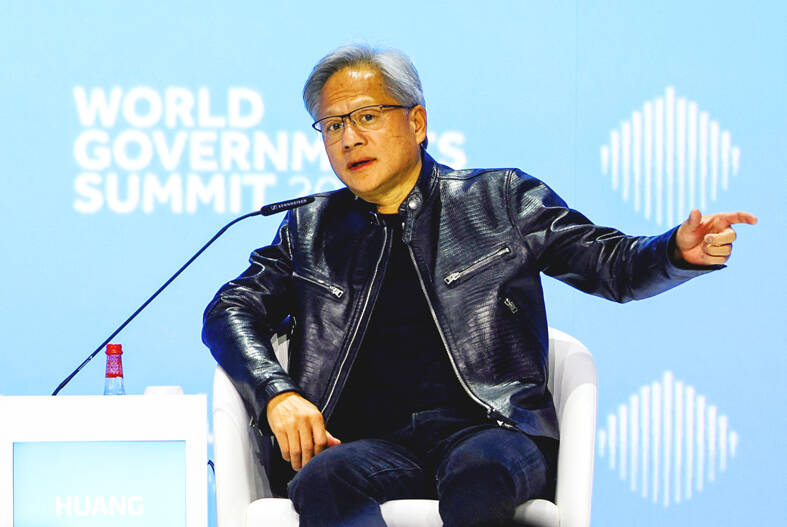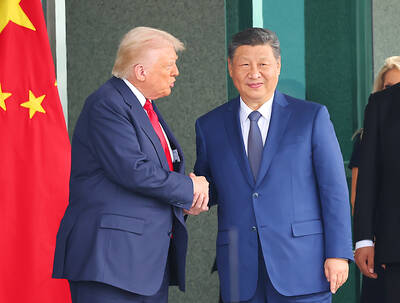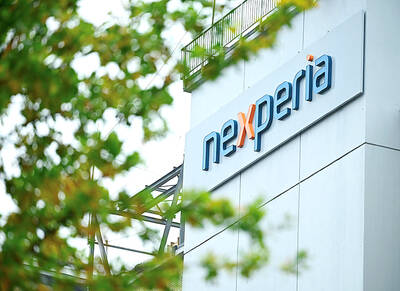Nvidia Corp chief executive officer Jensen Huang (黃仁勳) said yesterday that every country needs to have its own artificial intelligence (AI) infrastructure to take advantage of the economic potential while protecting its own culture.
“You cannot allow that to be done by other people,” Huang said at the World Government Summit in Dubai.
Huang, whose firm has catapulted to a US$1.73 trillion stock market value due to its dominance of the market for high-end AI chips, said his company is “democratizing” access to AI due to swift efficiency gains in AI computing.

Photo: Reuters
“The rest of it is really up to you to take initiative, activate your industry, build the infrastructure, as fast as you can,” he said.
He said that fears about the dangers of AI are overblown, adding that other new technologies and industries such as cars and aviation have been successfully regulated.
“There are some interests to scare people about this new technology, to mystify this technology, to encourage other people to not do anything about that technology and rely on them to do it. And I think that’s a mistake,” Huang said.
Huang anticipates advances in computing over the next few years will keep the cost of developing AI well below the US$7 trillion that Sam Altman is said to be fundraising.
“You can’t assume just that you will buy more computers. You have to also assume that the computers are going to become faster and therefore the total amount that you need is not as much,” Huang told the summit.
The 60-year-old’s company makes the most sought-after AI accelerators and he’s confident the chip industry will drive down the cost of AI, as those parts are made “faster and faster and faster.”
Huang was responding to a report in the Wall Street Journal that OpenAI CEO Sam Altman is seeking to raise US$7 trillion from investors in the Middle East, including the United Arab Emirates, for a semiconductor initiative to power AI projects that would rival Nvidia.
Altman and other AI developers are seeking ways to diversify their hardware options, including by exploring chipmaking ventures of their own. For Altman to have a realistic chance of making a dent in their lead, he would need to spend lavishly on research, development, facilities and expert personnel, but Huang’s view would suggest that better, more cost-efficient chips will make that unnecessary.
Still, the Nvidia CEO doesn’t see an end to the increase in AI spending anytime soon. In his remarks, Huang estimated that the global cost of data centers powering AI will double in the next five years.
“We’re at the beginning of this new era. There’s about a trillion dollars’ worth of installed base of data centers. Over the course of the next four or five years, we’ll have US$2 trillion worth of data centers that will be powering software around the world,” he said.
Separately, Australia is lagging international peers on the adoption of AI and other advanced technologies, according to the Productivity Commission.
We are “pretty much toward the bottom of the pack of OECD nations,” Danielle Wood, chair of the commission, said at the AFR Workforce Summit yesterday, referring to Australia’s rich-world counterparts in the Organisation for Economic Co-operation and Development.
“So there is a really important question, not just how does the government get the policy settings right and there’s a huge amount to be done there, but how do we shift closer to that frontier when it comes to technological adoption?” Wood said.
A government report last year predicted that Australia’s productivity growth would be 1.2 percent annually in the long term, down from 1.5 percent in the same report two years earlier. The 0.3 percentage point drop in productivity would cut estimated real GDP over the next 40 years by almost 10 percent.
Wood said she was optimistic about the overall impact on productivity from AI adoption in fields such as healthcare, education and retail and “less concerned about some of the negative workforce fallouts.”
“On the jobs piece, we have been through these kind of waves of technological changes before,” Wood said. “It may be that this time is different to history, but certainly what history, at least to date has shown is every time we get one of these waves of change, net job creation is greater than job destruction.”

RUN IT BACK: A succesful first project working with hyperscalers to design chips encouraged MediaTek to start a second project, aiming to hit stride in 2028 MediaTek Inc (聯發科), the world’s biggest smartphone chip supplier, yesterday said it is engaging a second hyperscaler to help design artificial intelligence (AI) accelerators used in data centers following a similar project expected to generate revenue streams soon. The first AI accelerator project is to bring in US$1 billion revenue next year and several billion US dollars more in 2027, MediaTek chief executive officer Rick Tsai (蔡力行) told a virtual investor conference yesterday. The second AI accelerator project is expected to contribute to revenue beginning in 2028, Tsai said. MediaTek yesterday raised its revenue forecast for the global AI accelerator used

TEMPORARY TRUCE: China has made concessions to ease rare earth trade controls, among others, while Washington holds fire on a 100% tariff on all Chinese goods China is effectively suspending implementation of additional export controls on rare earth metals and terminating investigations targeting US companies in the semiconductor supply chain, the White House announced. The White House on Saturday issued a fact sheet outlining some details of the trade pact agreed to earlier in the week by US President Donald Trump and Chinese President Xi Jinping (習近平) that aimed to ease tensions between the world’s two largest economies. Under the deal, China is to issue general licenses valid for exports of rare earths, gallium, germanium, antimony and graphite “for the benefit of US end users and their suppliers

Dutch chipmaker Nexperia BV’s China unit yesterday said that it had established sufficient inventories of finished goods and works-in-progress, and that its supply chain remained secure and stable after its parent halted wafer supplies. The Dutch company suspended supplies of wafers to its Chinese assembly plant a week ago, calling it “a direct consequence of the local management’s recent failure to comply with the agreed contractual payment terms,” Reuters reported on Friday last week. Its China unit called Nexperia’s suspension “unilateral” and “extremely irresponsible,” adding that the Dutch parent’s claim about contractual payment was “misleading and highly deceptive,” according to a statement

Artificial intelligence (AI) giant Nvidia Corp’s most advanced chips would be reserved for US companies and kept out of China and other countries, US President Donald Trump said. During an interview that aired on Sunday on CBS’ 60 Minutes program and in comments to reporters aboard Air Force One, Trump said only US customers should have access to the top-end Blackwell chips offered by Nvidia, the world’s most valuable company by market capitalization. “The most advanced, we will not let anybody have them other than the United States,” he told CBS, echoing remarks made earlier to reporters as he returned to Washington